An interesting piece of arcade minutia to share this week.
Atari’s upright Battlezone cabinet is an imposing beast. Standing at just over 6 feet tall, the machine towers over the player and most of its contemporaries. Although shared by Atari title Red Baron, the cabinet design is instantly recognizable by its sheer size and bright artwork. Some 13,000 Battlezone uprights rolled off of Atari’s production lines in the early 80s.

Despite its size and height, the cabinet is surprisingly stable. Why? Much of the weight is actually lower down the cab. The machine used a clever “mirror” setup – the vector monitor is positioned inside the cabinet at the same height as the controls and points upwards. What the player actually looks at is an angled mirror, which projects the images from the monitor in their direction. This creates a cool floating effect to the graphics. Space Invaders used a similar setup.

It was one of the first cabinets to attempt to add a sense of immersion. As well as arguably being the godfather of all first person video games that followed, the plastic periscope mold on its front, together with the twin stick controllers were created to give players more of a sense of actually being inside the tank, travelling around the barren landscape in search of other enemy tanks and UFOs to destroy. Looking through the periscope to play, shuts out large parts of the outside world – the theory being the player gets a more intense experience. An early form of today’s VR headsets if you will.
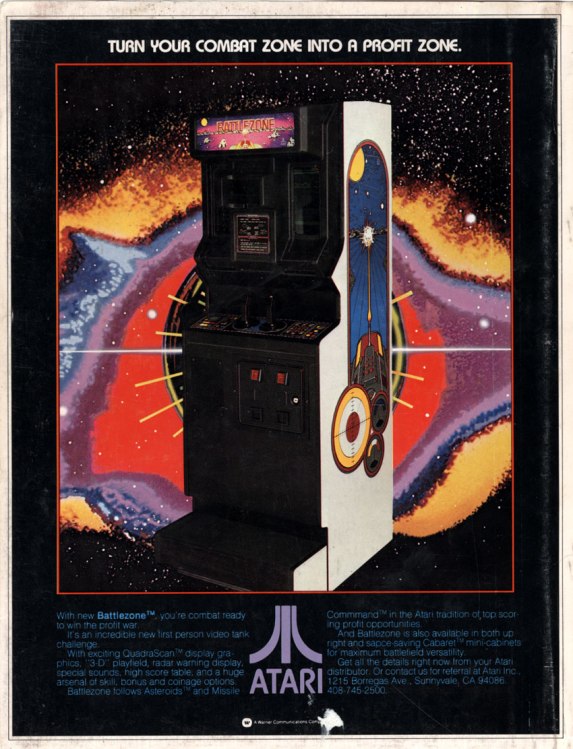
The downside? Enclosing the player’s senses to get closer to the game’s action, means it is difficult for other players to watch what was going on.
To combat this (pardon the pun), towards the end of the game’s release, a redesign was developed that removed the periscope from the front of the game, making the game “full-face”. This had the benefit of allowing younger players to access the game (many kids found the height of the periscope a problem) and, this was an obvious solution to the issue of giving other people in the vicinity the ability to watch the action (and thus get excited about the game = more coin!)

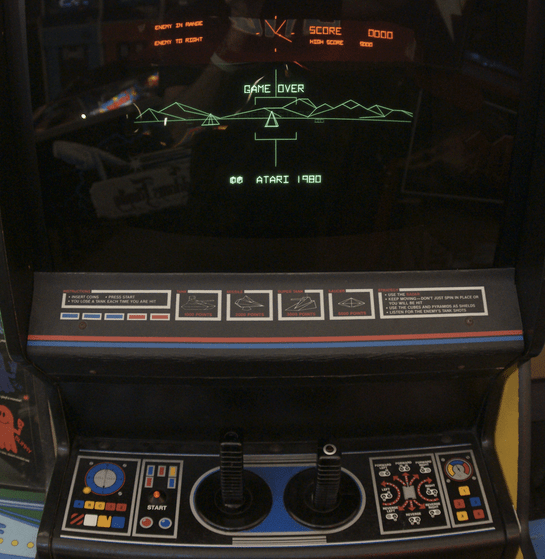
But there’s a bit more to the story.
A thread appeared on KLOV arcade collectors forums back in 2010, titled Strange Holes in Battlezone cabinet. User ‘hatrick’ shared pictures of two holes he noticed towards the top of both sides of the cabinet. They appeared to be well made, and were plugged with plastic lugs. As they were done with a reasonable amount of precision and accuracy, it was fair to assume that these were made at the factory rather than by a cack-handed operator or owner.

But what were they for? A number of theories were put forward: Perhaps the holes were drilled to mount some sort of additional marquee? Were they vent holes, designed to dissipate the heat generated by the early technology inside the cabinet? Or perhaps strap holes, allowing operators to secure the cabinet to a wall to prevent it from tipping over onto over-exuberant players?
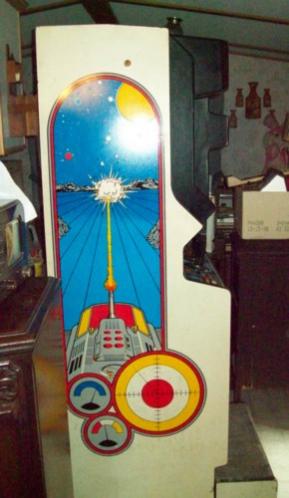
Other suggestions included holes for carrying handles to be added, either to aid manoeuvrability in the factory as the cabinets were being built, or handles for the Bradley Trainer version of the game, demanded by the American military to make the cabinets easier to move around on site.
Another plausible suggestion was that these were design errors. Someone mistakenly programmed the CNC wood router designs, and the machines cutting the wood produced these holes – it could be that a third party company contracted to Atari to build the wood cabinets screwed up a batch, and by the time it was noticed, a quick and cost-effective solution was to plug the holes with the lugs, rather than destroy and re-do these cabinets?

These were all solid ideas, but no one knew for sure. More collectors came forward, sharing the details of their cabinets and serial numbers. Some six years since the original thread was started, a pretty detailed inventory has been put together. What it shows us from the data collated is that:
Serial numbers 0-997 – no mystery holes.
Serial numbers 997-2,250 – mystery holes
2558- 13,000 – no mystery holes
There are 19 examples of owners who came forward stating that their Battlezone cabinets had these holes, and all had serial numbers between the range of 997 to 2,250. Serial numbers across any other range didn’t have these holes.
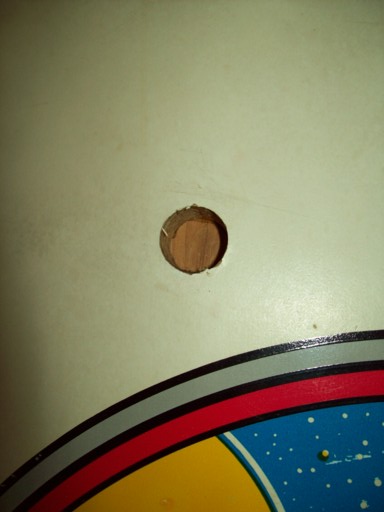
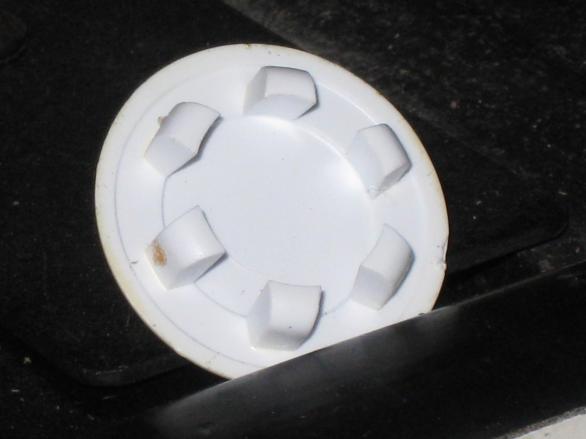
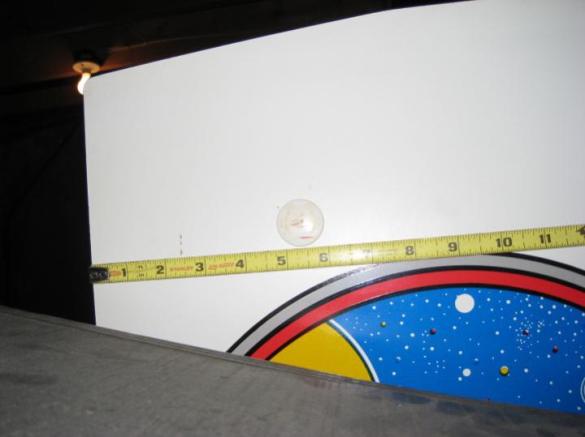
So whatever the reason, it seems the production run started without holes, then at some point a decision was made to add them during a run of approximately 1,000 cabinets, then no more from there on in.
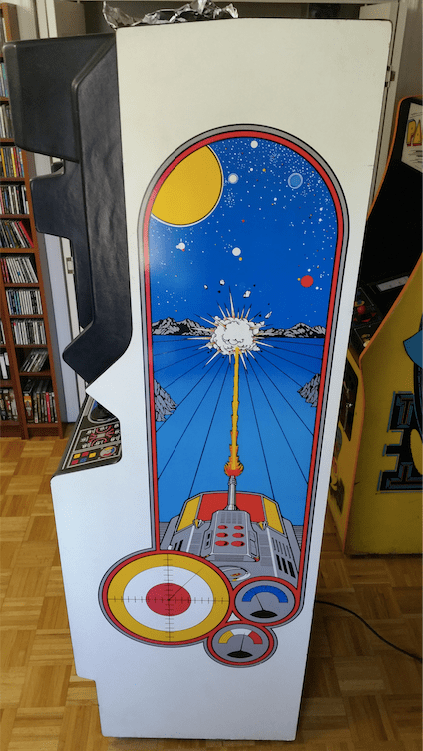
But why would Atari drill into the artwork in such a brutal way? It seems someone reached out to Ed Rotberg, designer of the game, but he had no recollection of these holes or why they might have been there.
I’ve been fortunate enough to have a semi-regular dialogue with Jed Margolin, and thought I’d ask him if he knew anything about this. Jed was an engineer at Atari and worked with Ed on the Battlezone game. Sure enough,he was able to shed some light on the mysterious holes! So I put three scenarios to Jed:
Was the wood used left over from a cancelled Bradley Trainer order? Perhaps the holes were specced onto those cabinets?
Jed: No, the Bradley Trainer project came later in the life cycle of this game.
Were the holes intended to accommodate straps to secure the cabinets against a wall, preventing them from tipping over?
Jed: No, the game was stable on its own. It had to be. Otherwise the game would have had to be next to a wall and the operators would have complained. Also some operators would have failed to strap it and if the game injured someone we would have been sued.
Were the holes there for some sort of bracket to hold a second monitor on top of the game, allowing other people to watch what was going on?
Jed: Ding! Ding! Ding! I never liked the bezel/shroud because it made it difficult for other players to watch. I really didn’t like the mirror either. We made the second monitor but I don’t know if anyone bought them. Apparently not, as it seems (according to your data) we stopped making the holes for it.
And by the way, towards the end of the Battlezone run, they were made without the bezel/shroud periscope and mirror (the ‘full-face’ Battlezone cabinet design). The monitor was right in front of you rather than being displayed on the mirror.
Jed was unable to recall exactly how the monitor was mounted, and didn’t think he had any documentation to confirm this, but he was explicit in saying that the holes were intended for this purpose. It appears this was an idea that never came to fruition – either Atari never proceeded with the idea, or the demand from operators simply wasn’t there.
Once a decision was made, the holes were no longer routed into the cabinet sides.
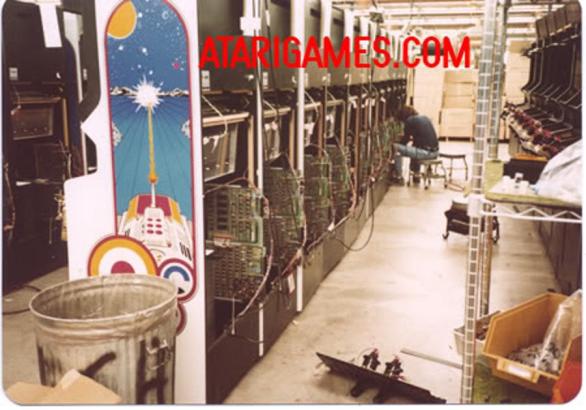
I discussed a little more with Jed about the full-face design, and he suggested that the full-face Battlezone may have been primarily a commercial decision – those periscope molds were incredibly expensive to produce. The ability for other players to watch the game play also happened to be a nice side benefit. Adding to the cheaper build cost was the removal of the mirror – this required a jumper change to reverse the axis of the vector generation on the PCB because the monitor didn’t need to be reversed as it sat in front of the player:
It was because we had planned for the cabaret version that the vector generator has the ability to reverse the axis (I think it’s a jumper) so no software had to be rewritten. Removing the mirror out of the upright would change one of the axis.
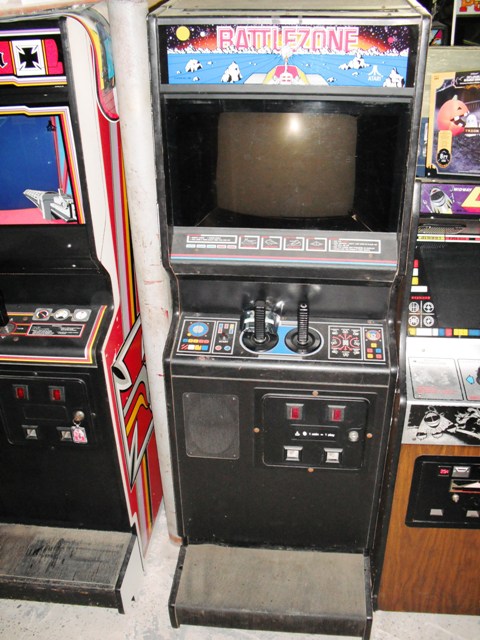
Another thought I had was that if another monitor was placed on top of an arcade cabinet the size of Battlezone, it would make it rather unstable. Perhaps the additional risk of Atari being sued by an injured player played a part in the decision not to go ahead with it?
That said, other manufacturers had similar ideas:
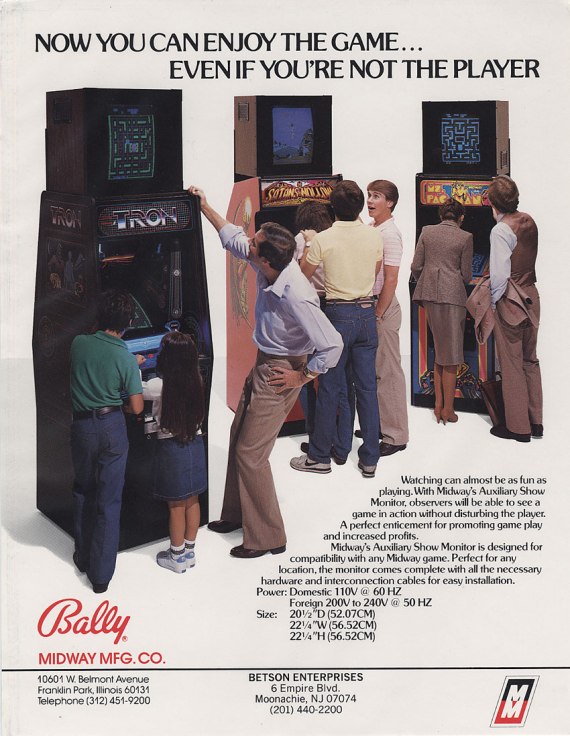
So there you have it. Another cool piece of the arcade history jigsaw seemingly solved! All we need now is an image of this dual monitor set up in action!
Many thanks to the guys over at KLOV for the investigative work, and for taking the time to document their cabinets and share photos of the holes that I’ve reposted here – especially user sg6970 for maintaining and updating the cabinet ‘holes’ database for such a long period of time! And of course to Jed Margolin for once again allowing me to pester him with random questions about his time at Atari some 40 years ago. Thanks everyone.
If you’re interested, the original forum thread is here.
As always, I appreciate your visit this week.
Tony

In the early 80’s, the Circus Circus arcade in Great Yarmouth had a TX1 3 monitor arcade machine linked to a full size F1 car replica that you sat in to play it. As you can imagine, it was huge! What made it even more of an impressive site though, were the extra 3 monitors on top of the arcade machine for spectators!
LikeLiked by 1 person
I know that Sega also sold a “slave” monitor to sit on top of their “convert-a-cab” style cabinets. I know because I have one. Same woodgrain covered particle board, with an Electrohome G-08 inside for showing what’s going on with one of their vector games. Does anyone else have one of these?
LikeLike
Great detective work Tony and a fascinating read to boot. Thanks.
LikeLike
Back in the 80s, I was the head service tech for Novel Amusements in NYC, a major NYC area distributor. One day I was in the shop working on some dead boards when one of the warehouse guys came to get me, saying they had a boxed game on the truck that sounded like it had broken glass. I went back to the warehouse and found the game was a Battlezone, one of the first twenty in NYC, and yeah, just nudging the box produced the distinctive tinkle of busted glass. I checked the Shockwatch and Tip-N-Tell labels on the box and they showed no signs of abuse so I wasn’t sure what could have broken or how but grabbed a ladder and had the warehouse guys unstrap the top of the box so I could look down inside. As soon as that cardboard came off I yelled to the warehouse foreman to get his camera (shipping damage was always documented and photographed) and another ladder. It had taken a second or two for my brain to process what I was seeing because I didn’t often see that part of a machine but there was no denying that I was looking that the BOTTOM of a machine. Yeah, from the factory it got boxed upside down. How it happened is anyone’s guess but we figured that someone didn’t notice that the cardboard sleeve that goes over the machine and is then “capped” on both ends was put on upside down. From there the unit got moved to the shipping department where someone turned it right side up, put the Shockwatch and Tip-N-Tell on it, and loaded it on the truck. Somewhere in that journey the power supply broke loose and fell, breaking the mirror and smashing the CRT. The machine was a total write-off and went into a dumpster after the company was credited for it.
LikeLiked by 1 person
Great story! What are “Tip-N-Tell” and “Shockwatch” labels?
LikeLike
Tip-n-tells are indicators applied to the sides of a package that permanently indicate to what degree the package was tilted. Shockwatch indicators are attached to show how much abuse a package has taken, such as it it were dropped.
You can find both and learn more about them at this link: https://www.interplas.com/tip-n-tell-indicators-p-dnt-1-tnt#:~:text=Tip%2DN%2DTell%20is%20a,package%20and%20bill%20of%20lading.
LikeLiked by 1 person